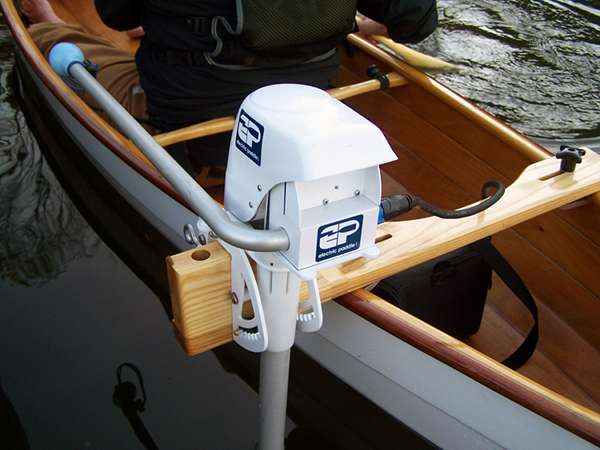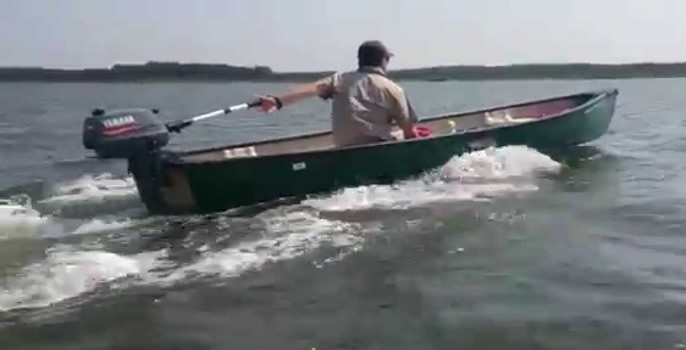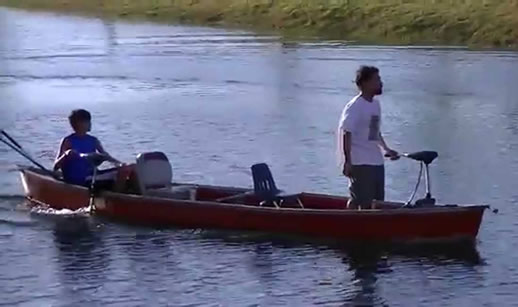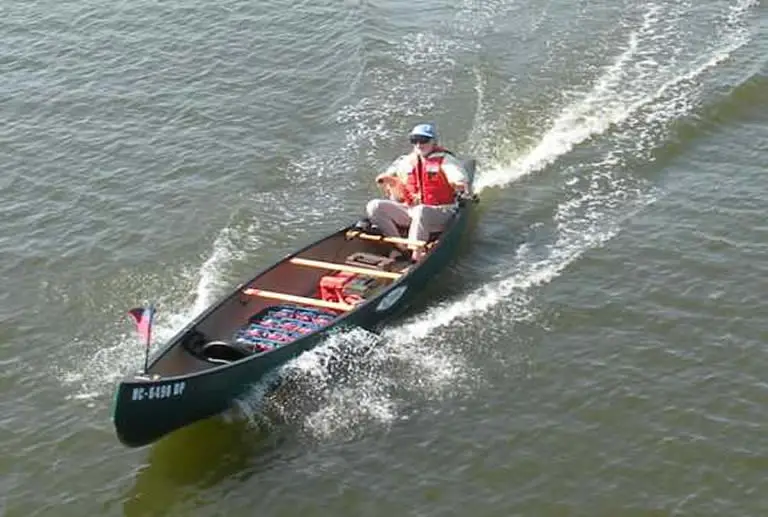Contents
- It Is Possible To Setup A Trolling Motor For Canoe Use
- The Best Trolling Motor For A Canoe Is A Trolling Motor
- Why You Should Consider Choosing An Electric Trolling Motor For Canoe Use
- Why You Should Consider Choosing A Gas Trolling Motor For Canoe Use
- 2 Key Considerations Before Choosing A Canoe Motor
- How to put a trolling motor on a canoe
- Bow Mounted Canoe Trolling Motor
- Transom Mounted Canoe Trolling Motor
- The Benefits Of Mounting Both Bow & Transom Motors
It Is Possible To Setup A Trolling Motor For Canoe Use
I often get asked by friends if it’s possible to motorize a canoe. Can you put a motor on a canoe?
You can put a trolling motor on a canoe. However, there are restrictions to the type and size of motor you can mount.
Both electric and gas powered trolling motors can be used on a canoe though electric motors are preferred because they are lighter.
Let’s take a look at how you can put a trolling motor on a canoe.

The first step involves finding the right canoe motor.
The trolling motor you pick for your canoe will depend on the size of your boat.
Bigger boats need more power, but too much power and you could end up in the river bank.
Below I show you the benefit, and highlight the drawbacks, of the two different types of trolling motor for canoe use.
The Best Trolling Motor For A Canoe Is A Trolling Motor
When it comes to fitting a canoe with outboard motor power, there are two main categories of motor that people commonly fit to canoes.
Both are trolling motors.
The best trolling motors for canoes are either:
- An electric powered trolling motor.
- A gas powered trolling motor.
Why You Should Consider Choosing An Electric Trolling Motor For Canoe Use
Electric powered trolling motors are powered by powerful batteries and are usually the more popular choice of trolling motor for the canoe owner.
Electric motors are much lighter than gas motors and are smaller.
Not only do you reduce weight with the motor itself but because you have no need of a gas tank, filled with heavy gasoline, you free up even more weight.
Electric motors can be easily installed with a clamp and many modern motors have more features and functionalities compared to heavy gas-powered trolling motors.
Most electric trolling motors today have features such as a display screen.
This screen allows you to track and save your routes and spots, GPS, and auto-pilot systems in addition to the standard gauge that shows how much “juice” the battery has left.
A good electric trolling motor will power your canoe for many years.
Voltage requirements for a canoe electric motor
When it comes to creating an electric canoe you will need, as a general rule, a 12 Volt batter for every 60lbs of thrusting power.
The more your canoe weighs, the higher voltage battery or the more batteries, you will need.
The electric trolling motors that fit well with canoes are usually powered by 12 Volt, 24 Volt or even 36 Volt batteries.
As such, before you decide on an electric trolling motor, estimate and assess your canoe’s total weight to ensure that you will not be losing power in the middle of your canoeing.
While you can always just use your paddles, it is still better to know these things to avoid mishaps and inconveniences along the way.
As a guide, experts advise you to get a 12 V electric trolling motor if you will require 60lbs of thrust, and the 24 V if you desire up to 80lbs of thrust.
For those that need more power 36 V battery is required for 105lbs of thrusting power.
However, most canoers go for 12 V electric motors because canoes are meant to be lightweight and don’t handle well with a very heavy load.
For that reason many canoers will avoid mounting a gas powered motor. Some do though.
Why You Should Consider Choosing A Gas Trolling Motor For Canoe Use
Sometimes electric power just won’t cut it. If you have a fairly big boat then you may need more power.
In this case you will want to opt for a gas powered canoe over an electric one.
Using a canoe gas motor has its advantages, but it also has its disadvantages.
Most canoers that choose to use a gas powered trolling motor on their canoe have prioritized speed and power over everything else.
Gas-powered trolling motors are much heavier than electric trolling motors and they are also bigger.

What’s more they require a gas tank thus taking up more space on the boat and the additional weight of gasoline is also a major drawback to using these motors.
Furthermore, they are also noisy and can be messy at times.
Gas powered trolling motors also require greater regular maintenance than their electric counterparts which can be a hassle for most.
On the positive side gas powered motors are a lot more powerful than electric motors and with a full tank will probably power the boat for longer periods during sustained use.
This can be overcome on an electric powered canoe by simply carrying an extra battery which still amounts to less weight than a gas motor.
Gas powdered motors are more powerful and will keep you motorized on the water for longer periods.
Electric motors are lighter and require less maintenance.
What size trolling motor for a canoe is best? – The ideal horsepower of gas canoe motor
The thrusting power of gas-powered trolling motors is measured by horsepower (HP). The higher the power is, the better the thrusting power it will give.
However, be aware that power is also directly proportional to the weight of the motor.
Thus, for your canoe, you might want to balance things out and take into consideration the total weight of your canoe, including its load.
As a guide, 100lbs of weight will require 2 HP to move a canoe. And if you consider other factors such as wind and current, then you will need to adjust and increase the thrusting power.
For most canoers, a 2 HP gas-powered trolling motor is usually enough.
Too much HP may send your canoe into the banks in the same way a powerful gas motor can send a drift boat out of control as we outlined here.
That article will give you some insight into the dangers of mounting a powerful gas motor to a boat that was never designed to use a motor in the first place.
It is advisable to mount a low powered electric trolling motor to your canoe.
A short shaft electric trolling motor is by far the best option for most small canoes that are used in shallow waters.
2 Key Considerations Before Choosing A Canoe Motor
1. Will you use the canoe trolling motor in freshwater or saltwater?
Can you use a freshwater trolling motor in saltwater?
Most trolling motors are designed for either saltwater or freshwater use.
Most people neglect to check this factor when buying motors for their boat.
This can cause problems later down the line.
For example, if you don’t want to end up stalling in the middle of water because you used a freshwater trolling motor on saltwater, then you need to make sure that the trolling motor that you will be using is compatible with the type of water you will be venturing to.
Saltwater trolling motors are specifically designed to withstand the corrosive effects of saltwater.
They are usually made with high-quality stainless steels and their electrical systems are more secured with seals to prevent saltwater from corroding vital working parts of the engine.
Thus, saltwater trolling motors are usually more expensive compared to freshwater trolling motors.
While, freshwater trolling motors are generally cheaper because they don’t require the same type of protection from saltwater.
While using a saltwater trolling motor on either freshwater or saltwater won’t pose a problem nor will it lead to any engine damage the same is not true for a freshwater trolling motor.
Using a freshwater trolling motor on salt water will corrode the motor and damage it quickly.
Furthermore, it will also void the warranty of the motor leaving you out of pocket and without a motor.
So make sure you avoid this blunder by ensuring you only get a freshwater trolling motor if you never intend to venture into saltwater.
A good saltwater trolling motor with all the bells and whistles that is well suited to a large canoe is more expensive than an equivalent electric one. It also offers more power but be aware that both motors will work well with a standard sized canoe.
For more information on galvanic corrosion caused by saltwater read our article can you use a jon boat in saltwater.
2. Shaft length matters when it comes to mounting a canoe motor
Checking the shaft length is another important factor that you should consider before you buy a trolling motor.
The trolling motor shaft length for canoe use is an important consideration.
If the shaft is too short, then you will find it hard to move and maneuver in deep and dangerous rough waters.
If you do boat in these type of waterways then choosing a short shaft trolling motor for canoe mounting is best.
On the other hand, if the shaft is too long, then it might collide with rocks or get stuck in the shallow waters that canoes are often used in.
To decide on the ideal shaft length, think about where you will be using the motor and assess the depths of the water from the shore up to your usual fishing or boating spots.
This will help you decide on a minimum shaft length.
And from that minimum length, you can adjust and increase it so that you can still move quickly and nimbly as you go in the deeper fishing spots.
How to put a trolling motor on a canoe
Knowing where you want to mount the trolling motor on your canoe is a very important piece of information that you should consider before you go shopping for a trolling motor.
Trolling motors can be mounted at either the bow or the transom.
Each location offers its own advantages and learning about them will help you decide on which mounting position is best for you.

Bow Mounted Canoe Trolling Motor
Bow mount trolling motors tend to offer better handling and maneuverability than transom mounted motors.
Furthermore, a bow mount motor has some useful features and functionalities.
They are also usually bigger than trolling motors mounted on the transom.
However, bow mount motors are on the more expensive side when compared to the other motors.
Because a bow mount motor is also bigger it will take up more space on your canoe than its counterpart.
So before you jump in and start searching for the perfect bow mount motor let’s take a look at the alternative.
Canoe with bow mounted trolling motor (video)
Transom Mounted Canoe Trolling Motor
The cheapest and the smallest trolling motors are transom mount motors.
Using a clamp, a transom motor can be easily installed or mounted at the stern of the boat.
They are a popular choice for canoers and other small boat users (like Jon boats, kayaks and drift boats) because of the size limitation of their boats.
Furthermore, transom motors don’t take a lot of space so it will feel like nothing is added to a small boat.
In conclusion, if you have reached this point in the article, then you are now ready to shop and choose the trolling motor for your canoe.
As long as you remember all the information I mentioned above, then finding the perfect motor for you will be a breeze.
Fishing canoe with transom mount trolling motor (video)
Video: https://www.youtube.com/watch?v=j2dAJRKhZ_s
It is possible to have a canoe with trolling motor bow mounted and transom mounted options.
This will give you much more control and offer you the advantages offered by both bow and transom trolling motors without any of the drawbacks. Because you can use just one motor at a time.
However, the canoe would need to be fairly large as you would lose the space that is occupied by two engines instead of just one.
The Benefits Of Mounting Both Bow & Transom Motors
With the addition of a simple canoe trolling motor mount, like these, it is possible to mount a trolling motor to the bow or the transom.
But have you considered mounting both?
The same type of trolling motor mount for canoe use can used to mount both a transom and bow motor, giving you much more control over your boat.

